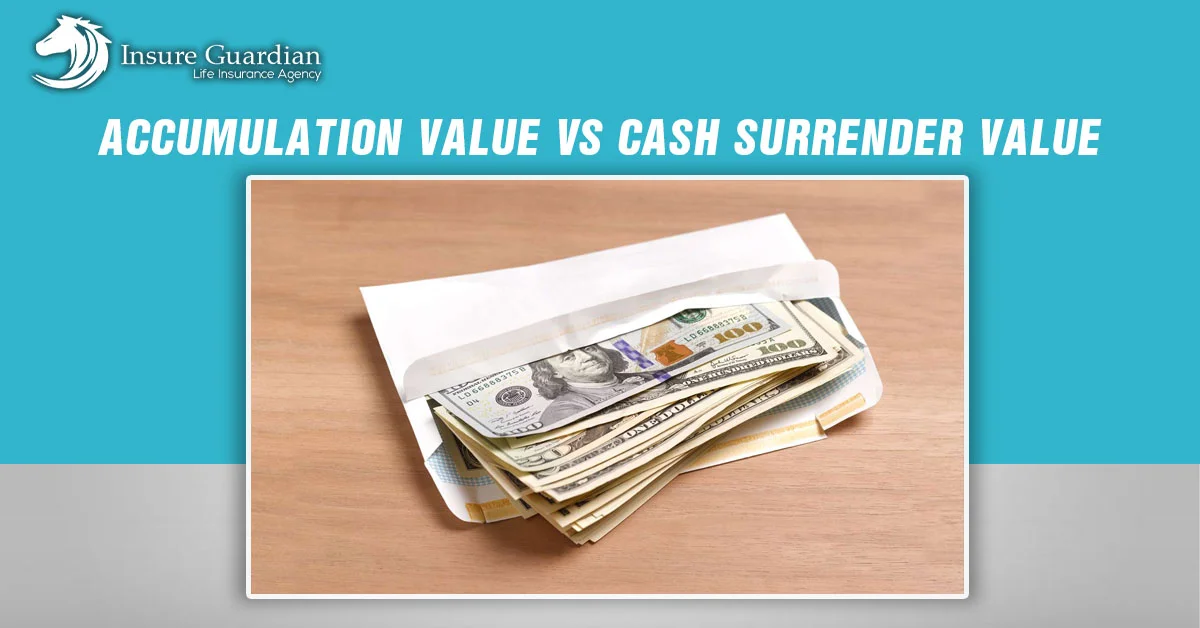The fundamental distinction between the accumulation value and cash surrender value is any surrender charge applied to the life insurance or annuity contract. The total accumulated cash value in the policy is referred to as the accumulation value. The accumulated value less any applicable surrender charge or market value adjustment equals the cash surrender value.
However, it is critical to recognize that surrender charges do not apply to all types of life insurance. Furthermore, surrender charges rarely endure the length of the insurance contract, so you should understand how they function to assess how they may affect the cash value of your policy.
Is the value of surrender the same as the value of cash?
The surrender value of a life insurance or annuity contract is sometimes the same as the cash value. In virtually all circumstances, this is true for whole life insurance because it does not typically have a surrender charge. This is also true for several types of universal life insurance and annuities with no surrender charge.
However, if an insurance policy contains an active surrender charge, the surrender value will be less than the cash value of the insurance policy. For the first several years of the policy, this regulation applies to the majority of universal life insurance and annuity contracts.
Eventually, all surrender charges are dropped. At this moment, the cash value and the surrender value are the same. When a life insurance or annuity contract has an active surrender charge, we refer to this as the surrender period. The surrender time ends when the surrender charge is no longer active.
Assume you purchase a universal life insurance policy with a surrender charge that applies for the first ten policy years. The policy has a 10-year surrender period.
How Much Is the Total Cash Surrender Value? How Is Surrender Value Determined?
The total cash surrender value of a life insurance policy is the difference between the cumulative cash value and any relevant surrender charge or market value adjustment. Assume you had a universal life insurance policy with a cash value of $20,000, for example. The current surrender charge is 10%. This means that if you cancel the policy, the insurance provider will keep 10% of the total cash value. In this case, you will earn $18,000 if you cancel the coverage. The insurance company would retain $2,000 of the total cash value.
If there was no surrender charge on the policy, you will receive the entire $20,000 upon cancellation. The surrender value and cash value are the same in this scenario. During the surrender term, several life insurance and annuity contracts have a market value modification. To some, the MVA may appear to be a daunting calculation. The concept of a market value adjustment, on the other hand, is quite easy. The MVA is simply an adjustment to the cash surrender value depending on interest rate movement over a set period specified in the policy contract.
It’s critical to note that not all market value adjustments lower an insurance policy’s surrender value. In some cases, the MVA might raise a policy’s surrender value. This happens because market value adjustments account for the change in bond values held by the insurer to produce the cash benefits of the insurance policy.
What Happens When a Policy Is Sold For Cash?
When a policyholder decides to cancel his or her policy and the policy has a cash surrender value, the insurance company will cancel the death benefit as well as any other aspects of the policy and give the policyholder the cash surrender value. In most cases, the process is completed within 30 days.
In general, the terms of the life insurance policy remain in effect until the money is transferred to the policyholder by the life insurance company. This means that when a policyholder requests policy cancellation, the characteristics of the insurance remain in effect until the cancellation is processed by the insurer.
For instance, Jim contacts his life insurance company and requests that his policy be surrendered for its cash value. The insurance needs time to process the policy cancellation. Jim dies within the time frame. If the life insurer has not yet processed the cancellation request, the death benefit of the policy will be paid to Jim’s beneficiary.
If, on the other hand, the life insurer processes the cancellation request, mails a check to Jim, and Jim dies while the check is in the mail, his beneficiary would not get the life insurance policy’s death benefit because the policy was terminated before Jim died.
How Much Does Life Isurance Cost?
When a policy is surrendered for cash value, the life insurer usually mails the policyholder a check for the cash surrender value amount. Although some insurers may allow electronic payment transfers, the majority of people prefer to write a check or transfer money via bank wire. If the cash surrender value of the policy exceeds the sum of premiums paid to the policy, the difference is taxable income to the policyholder.
Assume Jim’s policy has a cash surrender value of $100,000 and he has paid $75,000 in premiums too far. $25,000 of the monies he receives upon canceling his coverage will be considered ordinary income in the year he cancels his policy. The next year, he will receive a 1099-MISC, which he must file with his taxes and pay income taxes on this $25,000 income. Several life insurers will withhold a percentage of the cash surrender value if the policy is canceled. This withholding is given to the United States Treasury as an advance payment of potential income taxes owed. This is a stage that can be skipped during the insurance surrender process. If a policy is surrendered during the surrender term, the surrender charge will be deducted from the policyholder’s cumulative cash value. The remaining sum is the insurance policy’s cash surrender value.
Assume Jim’s policy has a 10% surrender price and a cash value of $100,000. Jim will earn $90,000 in cash if he cancels his policy. This sum of $90,000 represents the cash surrender value of his policy. Assuming Jim’s total premiums paid remain $75,000, he will now have $15,000 in income on which he will owe taxes. Jim does not receive an income tax deduction for the $10,000 retained by the life insurance company.
How Do You Stay Away From Surrender Charges?
The most straightforward strategy to prevent surrender charges is to keep your insurance policy in force until the surrender term finishes. For example, if you purchase a universal life policy with a surrender duration of ten years, you should keep the policy in existence until at least the eleventh policy year. If you terminate the policy in year 11 or later, you will not be charged a surrender charge.
Another way to avoid surrender charges is to employ an insurance contract’s free withdrawal amount option. This is a pretty typical provision on insurance contracts that include surrender charges. The free withdrawal amount is a proportion of the policy’s cumulative value that a policyholder can remove without incurring a surrender charge. The most common surrender fee is 10% of the cumulative value per year.
As an example, suppose you own a universal life insurance policy with a cash value of $100,000. In addition, there is now a 10% surrender charge on the policy. Your coverage also includes a surrender fee of 10%. This implies you can take $10,000 from the policy without incurring a surrender charge. You are not permitted to remove any further funds from the account until the next policy year without incurring a surrender charge.
Finally, policy loans might help you avoid surrender charges. Policy loans are not subject to surrender charges; nevertheless, if a surrender charge applies to a policy, it will limit the amount of accrued cash value you can borrow against. The cash surrender value of the policy will equal the maximum loan value.
For instance, if you own a universal life insurance policy with $100,000 in cash value and a 10% surrender price, you can borrow up to $90,000 from it.
Why Does It Matter To Insurance Companies?
Surrender charges are used by insurance firms to amortize the expense of acquiring a new insurance policyholder. This suggests that they are deferring the cost of acquisition for several years. If the policyholder holds the policy for the whole surrender period, the insurer has recouped all of its expenses related to obtaining the customer and no longer has to levy the surrender charge. If the policyholder cancels the policy during the surrender term, the insurance company uses the surrender charge to recoup expenses incurred in acquiring the customer that has yet to be repaid.
The alternative to a surrender charge is to impose a high fee against the policy from the beginning. While this is an option for an insurance business, a large amount of marketing research reveals that most insurance consumers despise the notion. So, to provide customers with what they want, life insurance companies use surrender charges rather than initial charges applied to policyholders.
You should be aware that the accumulated value of policy benefits from everything that a life insurance policy has to offer. So, while you may not be able to withdraw the entire amount if you cancel the policy, that money earns 100% of any earned interest relevant to the policy.
Assume you have a universal life insurance policy with a cash surrender value of $50,000 and a cumulative cash value of $100,000. For the entire year, the universal life insurance policy earns 4% interest. This 4% interest rate applies to the whole $100,000 in accumulated cash value.
Remember that cumulative value and surrender values are important to insurance firms because they represent the expenditures that the insurer incurred to place the policy but have not yet recovered. Despite the surrender price, you, the policyholder, continue to benefit from all of the policy’s features, and any interest payable is applied to your whole cumulative value.

Expert Life Insurance Agent and health insurance agent
Dylan is your go-to guy for life and health insurance at InsureGuardian. He’s helped over 2,500 clients just like you figure out the best insurance plans for their needs. Before joining us, Dylan was sharing his expertise on TV with Global News and making a difference with various charities focused on health. He’s not just about selling insurance; he’s passionate about making sure you’re covered for whatever life throws your way.






